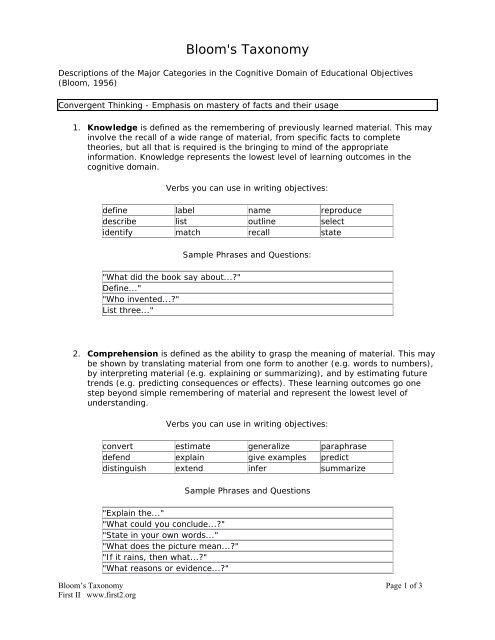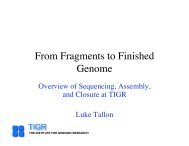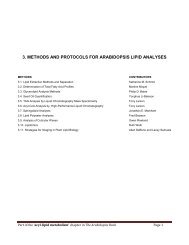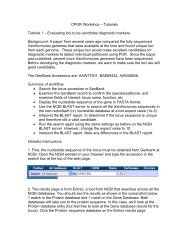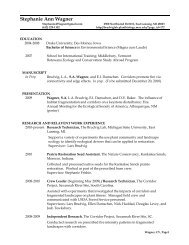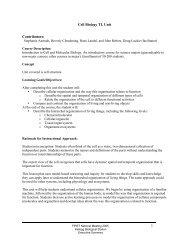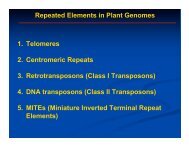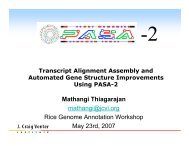Bloom's Taxonomy - first ii
Bloom's Taxonomy - first ii
Bloom's Taxonomy - first ii
Create successful ePaper yourself
Turn your PDF publications into a flip-book with our unique Google optimized e-Paper software.
<strong>Bloom's</strong> <strong>Taxonomy</strong><br />
Descriptions of the Major Categories in the Cognitive Domain of Educational Objectives<br />
(Bloom, 1956)<br />
Convergent Thinking - Emphasis on mastery of facts and their usage<br />
1. Knowledge is defined as the remembering of previously learned material. This may<br />
involve the recall of a wide range of material, from specific facts to complete<br />
theories, but all that is required is the bringing to mind of the appropriate<br />
information. Knowledge represents the lowest level of learning outcomes in the<br />
cognitive domain.<br />
Verbs you can use in writing objectives:<br />
define label name reproduce<br />
describe list outline select<br />
identify match recall state<br />
Sample Phrases and Questions:<br />
"What did the book say about...?"<br />
Define..."<br />
"Who invented...?"<br />
List three..."<br />
2. Comprehension is defined as the ability to grasp the meaning of material. This may<br />
be shown by translating material from one form to another (e.g. words to numbers),<br />
by interpreting material (e.g. explaining or summarizing), and by estimating future<br />
trends (e.g. predicting consequences or effects). These learning outcomes go one<br />
step beyond simple remembering of material and represent the lowest level of<br />
understanding.<br />
Verbs you can use in writing objectives:<br />
convert estimate generalize paraphrase<br />
defend explain give examples predict<br />
distinguish extend infer summarize<br />
Sample Phrases and Questions<br />
"Explain the..."<br />
"What could you conclude...?"<br />
"State in your own words..."<br />
"What does the picture mean...?"<br />
"If it rains, then what...?"<br />
"What reasons or evidence...?"<br />
Bloom’s <strong>Taxonomy</strong> Page 1 of 3<br />
First II www.<strong>first</strong>2.org
3. Application refers to the ability to use learned material in new and concrete<br />
situations. This may include the application of such things as rules, methods,<br />
concepts, principles, laws, and theories. Learning outcomes in this area require a<br />
high level of understanding than those under comprehension.<br />
Verbs you can use in writing objectives<br />
apply develop operate relate<br />
change discover predict show<br />
compute manipulate prepare solve<br />
demonstrate modify produce use<br />
Sample Phrases and Questions<br />
"If you know A and B, how could you determine C?"<br />
"What other possible reasons...?"<br />
"What might they do with...?"<br />
"What would happen if...?"<br />
Divergent Thinking - Emphasis on original thinking, open-ended answers, and a large<br />
number of possible solutions.<br />
4. Analysis refers to the ability to break down material into its component parts so<br />
that its organizational structure may be understood. This may include the<br />
identification of the parts, analysis of the relationships between parts, and<br />
recognition of organizational principles involved. Learning outcomes here represent a<br />
higher intellectual level than comprehension and application because they require an<br />
understanding of both content and the structural form of the material.<br />
Verbs you can use in writing objectives<br />
analyze Discriminate illustrate relate<br />
break down Distinguish infer select<br />
diagram Examine outline separate<br />
differentiate Identify point out subdivide<br />
Sample Phrases and Questions<br />
"What was the author's purpose, bias, or prejudice?"<br />
"What must you know to believe that to be true?"<br />
"Does that follow?"<br />
"Which are facts and which are opinions?"<br />
Bloom’s <strong>Taxonomy</strong> Page 2 of 3<br />
First II www.<strong>first</strong>2.org
5. Synthesis refers to the ability to put parts together to form a new whole. This may<br />
involve the production of a unique communication (e.g. theme or speech), a plan of<br />
operation (e.g. research proposal), or a set of abstract relations (e.g. scheme for<br />
classifying information). Learning outcomes in this area stress creative behaviors,<br />
with major emphasis on the formation of new patterns or structures.<br />
Verbs you can use in writing objectives<br />
categorize Design plan revise<br />
combine Explain rearrange rewrite<br />
compile Generate reconstruct summarize<br />
create Modify relate tell<br />
devise Organize reorganize write<br />
Sample Phrases and Questions<br />
"If no one else knew, how could you find out?"<br />
"Can you develop a new way?"<br />
"Make up..."<br />
"What would you do if...?"<br />
6. Evaluation is concerned with the ability to judge the value of material (e.g.<br />
statement, novel, poem, research report) for a given purpose. The judgments are to<br />
be based on definite criteria. These may be internal criteria (e.g. organization) or<br />
external criteria (e.g. relevance to the purpose) and the student may determine the<br />
criteria or be given them. Learning outcomes in this area are the highest in the<br />
cognitive hierarchy because they contain elements of all the other categories, plus<br />
conscious value judgments based on clearly defined criteria.<br />
Verbs you can use in writing objectives<br />
appraise criticize evaluate recommend<br />
compare describe judge relate<br />
conclude discriminate justify summarize<br />
contrast explain interpret support<br />
Sample Phrases and Questions<br />
"Which policy will result in the greatest good for the greatest<br />
number?"<br />
"For what reason would you favor...?"<br />
"Which of the books would you consider to be of greater value?"<br />
"Evaluate that idea in terms of cost and community acceptance."<br />
Adapted from Stating Behavioral Objectives for Classroom Instruction, by Norman E.<br />
Grolund. The Macmillan Company: New York, 1970.<br />
Bloom’s <strong>Taxonomy</strong> Page 3 of 3<br />
First II www.<strong>first</strong>2.org


